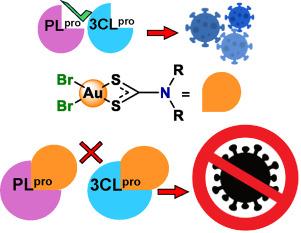Potent inhibition of SARS-CoV-2 proteases PLpro and 3CLpro by selected gold(III)-dithiocarbamato complexes showing strong and selective antiviral activity against HCoV-OC43
IF 3.2
2区 化学
Q2 BIOCHEMISTRY & MOLECULAR BIOLOGY
引用次数: 0
Abstract
Selected gold(III)-dithiocarbamato complexes were identified as potent inhibitors of two critical enzymes involved in the SARS-CoV-2 replication cycle, the papain-line protease (PLpro) and the 3-chymotrypsin-like protease (3CLpro), showing exceptional inhibition of PLpro with IC50 values in the range of 0.1–0.2 μM and rather moderate activity against 3CLpro (IC50 values 8–9 μM). Crucially, the inhibitory activity could be attributed to the presence of the gold(III) centre, as the gold-free dithiocarbamato ligand showed no significant activity against either proteases. The toxicity toward host cells, cellular uptake, and antiviral activity against the HCoV-OC43 coronavirus of the complexes were generally in good correlation to one another. Complexes Au-1 and Au-2 stood out as a highly active antiviral agents with a selectivity index above 90.

金(III)-二硫代氨基甲酸酯配合物对SARS-CoV-2蛋白酶PLpro和3CLpro的有效抑制,显示出对HCoV-OC43的强选择性抗病毒活性
选定的金(III)-二硫代氨基硫胺配合物被鉴定为参与SARS-CoV-2复制周期的两种关键酶,木瓜蛋白酶(PLpro)和3-凝乳胰蛋白酶样(3CLpro)的有效抑制剂,对PLpro的抑制作用在0.1-0.2 μM范围内,对3CLpro的抑制作用相当中等(IC50值为8-9 μM)。至关重要的是,抑制活性可能归因于金(III)中心的存在,因为无金的二硫代氨基氨基甲酸酯配体对两种蛋白酶都没有显着的活性。这些复合物对宿主细胞的毒性、细胞摄取和对HCoV-OC43冠状病毒的抗病毒活性总体上具有良好的相关性。配合物Au-1和Au-2的选择性指数均在90以上,是一种高活性的抗病毒药物。
本文章由计算机程序翻译,如有差异,请以英文原文为准。
求助全文
约1分钟内获得全文
求助全文
来源期刊

Journal of Inorganic Biochemistry
生物-生化与分子生物学
CiteScore
7.00
自引率
10.30%
发文量
336
审稿时长
41 days
期刊介绍:
The Journal of Inorganic Biochemistry is an established international forum for research in all aspects of Biological Inorganic Chemistry. Original papers of a high scientific level are published in the form of Articles (full length papers), Short Communications, Focused Reviews and Bioinorganic Methods. Topics include: the chemistry, structure and function of metalloenzymes; the interaction of inorganic ions and molecules with proteins and nucleic acids; the synthesis and properties of coordination complexes of biological interest including both structural and functional model systems; the function of metal- containing systems in the regulation of gene expression; the role of metals in medicine; the application of spectroscopic methods to determine the structure of metallobiomolecules; the preparation and characterization of metal-based biomaterials; and related systems. The emphasis of the Journal is on the structure and mechanism of action of metallobiomolecules.
 求助内容:
求助内容: 应助结果提醒方式:
应助结果提醒方式:


